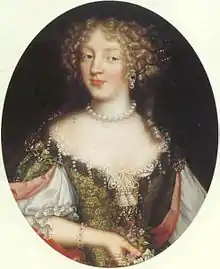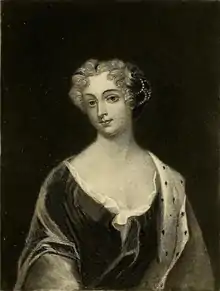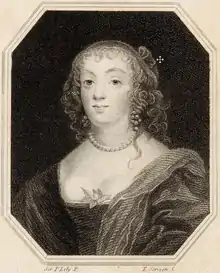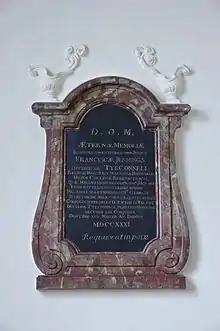Frances Talbot, Countess of Tyrconnell
Frances Talbot, Countess of Tyrconnell (née Jennings, previously Hamilton; c. 1649 – 1731) was a maid of honour to the Duchess of York and, like her sister Sarah, a famous beauty at the Restoration court. She married first George Hamilton and then Richard Talbot, Earl of Tyrconnell. She was vicereine in Dublin Castle when Tyrconnell was viceroy of Ireland for James II. She went through difficult times after the death of her second husband, who was attainted as a Jacobite, but recovered some of his wealth and died a devout Catholic despite having been raised as a Protestant.
Frances Talbot | |
|---|---|
| Countess of Tyrconnell | |
 | |
| Born | c. 1649 Sandridge, Hertfordshire, England |
| Died | 9 March 1731 Dublin |
| Spouse(s) | |
|
Issue
Elizabeth, Frances, & Mary | |
| Father | Richard Jennings |
| Mother | Frances Thornhurst |
Birth and origins
Frances was born about 1649[1] at Sandridge, Hertfordshire, England, as one of the nine children, four sons and five daughters[2] of Richard Jennings and his wife Frances Thornhurst. Her father was a landowner and a Member of Parliament. Her mother was a daughter of Sir Gifford Thornhurst, 1st Baronet. Her parents married in 1643.[3] Of the nine children only Frances and Sarah are noteworthy.
| Frances listed among her siblings |
|---|
She appears below among her siblings as the third child:
|
The spelling of her maiden name varied widely. All the three following forms were used during her lifetime: Jennings,[lower-alpha 1] Jenings,[9] Jenyns.[10]
Restoration court
She was about 11 when the Restoration (1660) brought the end of the Commonwealth and restored Charles II to the throne. In 1664, when about 15, Frances was appointed maid of honour to Anne Hyde, the Duchess of York. Anne was the first wife of the James, Duke of York, the younger brother of the King and future King James II. Her beauty earned her the nickname "La Belle Jennings."[11] Macaulay describes her as “beautiful Fanny Jennings, the loveliest coquette in the brilliant Whitehall of the Restoration."[12] She figures in the Mémoires du comte de Grammont (Memoirs for short), written by Anthony Hamilton, younger brother of her future husband George Hamilton, which describes the life at the Restoration court. The three oldest of the six Hamilton brothers, James, George, and Anthony, belonged to the inner circle around the King at Whitehall, as they had been in exile with him.
| Family tree | ||||||||||||||||||||||||||||||||||||||||||||||||||||||||||||||||||||||||||||||||||||||||||||||||||||||||||||||||||||||||||||||||||||||||||||||||||||||||||||||||||||||||||||||||||||||||||||||||||||||||||||||||||||||||||||||||||||||||||||||||||||||||||||||||||||||||||||||||||||||||||||||||||||||||||||||||||||||||||||||||||||||||||||||||||||||||||||||||||||||||||||||||||||||||
|---|---|---|---|---|---|---|---|---|---|---|---|---|---|---|---|---|---|---|---|---|---|---|---|---|---|---|---|---|---|---|---|---|---|---|---|---|---|---|---|---|---|---|---|---|---|---|---|---|---|---|---|---|---|---|---|---|---|---|---|---|---|---|---|---|---|---|---|---|---|---|---|---|---|---|---|---|---|---|---|---|---|---|---|---|---|---|---|---|---|---|---|---|---|---|---|---|---|---|---|---|---|---|---|---|---|---|---|---|---|---|---|---|---|---|---|---|---|---|---|---|---|---|---|---|---|---|---|---|---|---|---|---|---|---|---|---|---|---|---|---|---|---|---|---|---|---|---|---|---|---|---|---|---|---|---|---|---|---|---|---|---|---|---|---|---|---|---|---|---|---|---|---|---|---|---|---|---|---|---|---|---|---|---|---|---|---|---|---|---|---|---|---|---|---|---|---|---|---|---|---|---|---|---|---|---|---|---|---|---|---|---|---|---|---|---|---|---|---|---|---|---|---|---|---|---|---|---|---|---|---|---|---|---|---|---|---|---|---|---|---|---|---|---|---|---|---|---|---|---|---|---|---|---|---|---|---|---|---|---|---|---|---|---|---|---|---|---|---|---|---|---|---|---|---|---|---|---|---|---|---|---|---|---|---|---|---|---|---|---|---|---|---|---|---|---|---|---|---|---|---|---|---|---|---|---|---|---|---|---|---|---|---|---|---|---|---|---|---|---|---|---|---|---|---|---|---|---|---|---|---|---|---|---|---|---|---|---|---|---|---|---|---|---|---|---|---|---|---|---|---|---|---|---|---|---|---|---|---|---|---|---|---|---|---|---|---|---|---|---|---|---|---|---|---|---|---|
| ||||||||||||||||||||||||||||||||||||||||||||||||||||||||||||||||||||||||||||||||||||||||||||||||||||||||||||||||||||||||||||||||||||||||||||||||||||||||||||||||||||||||||||||||||||||||||||||||||||||||||||||||||||||||||||||||||||||||||||||||||||||||||||||||||||||||||||||||||||||||||||||||||||||||||||||||||||||||||||||||||||||||||||||||||||||||||||||||||||||||||||||||||||||||
An incident in which she disguised herself as an orange seller is told in the Memoirs and also, with less detail, in Pepys's diary. According to the Memoirs, she and her friend Miss Price wanted to consult a fortune-teller incognito. They went out disguising themselves as orange sellers.[13][14]
She was courted by the Duke of York, the future James II, who thought his wife's maids of honour to be his property, but she refused to play such a role.[15] She was also courted by Richard Talbot and by George Hamilton, second son of Sir George Hamilton.
First marriage and children
In 1665 Frances Jennings married George Hamilton.[16][17] At that time George was an officer in the Life Guards.[18] Her marriage resembled that of her husband's elder brother James, for whom the king arranged a marriage with a Protestant girl with the purpose of converting him to that religion. The King seemed to have been concerned about the future of his Catholic friends in the army. The King granted the couple a pension of £500 per year.[19] Hers is the sixth of the seven marriages with which end the Memoirs.[20]
Elizabeth, their first child, was born in 1667 and baptised on 21 March at St Margaret's, Westminster, in an Anglican ceremony.[21]
On 28 September 1667, all Catholic soldiers were dismissed from the Life Guards.[22] Hamilton then took French service. She followed him to France and changed to the Catholic religion.[23][24]
In 1671 Hamilton recruited a regiment in Ireland[25] and served under Turenne and then under his successors, first Condé and finally Luxembourg. Louis XIV created him a French comte and she therefore became comtesse Hamilton.
According to some the couple had six children,[26] but the only ones known by names seem to be the following three daughters who married:
- Elizabeth (1667–1724), married Richard Parsons, 1st Viscount Rosse in 1685, and was mother of Richard Parsons, 1st Earl of Rosse;[27][28]
- Frances (died 1751), married Henry Dillon, 8th Viscount Dillon in 1687;[29][30]
- Mary (1676–1736), married Nicholas Barnewall, 3rd Viscount Barnewall in 1688.[31][32]
Elizabeth, the first daughter, was born in England and baptised following the Anglican rite. She married Viscount Rosse, a Protestant loyal to James II, one of the only 5 Protestant lay members of the Irish House of Lords of the Patriot Parliament convoked by James II in 1688.[33] The other two daughters were born in France, baptised in the Catholic church, and married Catholic men.
Early in June 1676 comte Hamilton was killed by a musket-shot in a rear-guard action at the Col de Saverne[34] and she was widowed.
Second marriage

Frances remarried in 1681 in Paris, taking as her second husband an old suitor she had previously rejected: Richard Talbot.[26] Her husband was appointed Lord Deputy of Ireland (viceroy) and the couple lived in Dublin. He oversaw a dramatic expansion of the Irish Army, transforming it from a mainly Protestant to a Catholic force. Talbot was created Earl of Tyrconnell in the peerage of Ireland in 1685 and she became Countess Tyrconnell.[36]
In 1688 during the Glorious Revolution James II fled England and was replaced with Queen Mary and King William. However, in 1689 James II landed in Ireland trying to regain his kingdoms. Soon after his arrival, on 20 March 1689, he made Tyrconnell a duke and she became duchess.[37] This title is in the Jacobite peerage. Nonetheless, Frances is frequently called Duchess of Tyrconnell.[38] They had no children.
In 1690, after the defeat at the Battle of the Boyne, the king fled to their home and was met by Frances.[39] According to later sources, King James remarked, ‘Your countrymen, madam, can run well’ and Lady Tyrconnell replied, ‘Not quite so well as your majesty, for I see that you have won the race’.[40][41]
She fled to France and was one of the ladies-in-waiting of Mary of Modena, exiled Queen of England at Saint-Germain.[42]
Her husband died during the during the Siege of Limerick in 1691.
Later life

After her husband's death Frances was reduced to poverty and for a while, she had a dressmaker's stall at the New Exchange in the Strand in London. She dressed in white with her face covered by a white mask and was described as "the white milliner".[44] This episode was dramatised by Douglas Jerrold and performed at Covent Garden in 1841 under the title "The white Milliner: A Comedy in two Acts".(Jerrold 1841)
Following the accession of Queen Anne, Frances (and her stepdaughter, Charlotte Talbot) had some of her husband's former property restored to them by act of parliament — presumably assisted by her sister's influence with the Queen. Eventually she retired to the Dominican Convent at Channel Row[45] and lived there as a parlour boarder from 1723-1724.[46] She then built a house on North King Street in Dublin and obtained the permission to establish a Poor Clares convent in it.[47]
Death

In 1730 Frances died in Dublin at the Poor Clares convent that she had founded. She was buried on 9 March in St Patrick's Cathedral in Dublin.[48][lower-alpha 2]
She also funded a mass to be celebrated daily for ever at the chapel of the Scots College in Paris for the benefit of her soul and for those of both her husbands as can still be read on the memorial plaque affixed to the wall of this church (see photo). The Latin inscription translates into English as:
To God, most good, most great.
To the most illustrious and noble Lady
Frances Jennings,
duchess of Tyrconnell,
Lady-in-waiting of the Queen of Great Britain,
benefactrice of this College,
who founded a daily mass in this sanctuary
to be celebrated for ever
for her soul and those of Sir George
Hamilton of Abercorn, knight
her first husband and Sir Richard Talbot,
duke of Tyrconnell, Viceroy of Ireland,
her second husband.
She died on 17 March 1731
May she rest in peace
As the memorial plaque is in France, the text gives the date of her death according to the Gregorian calendar, which had been adopted in France in 1582 but was adopted in England only in 1752. This new-style date (17 March 1731) differs from the old-style date usually found in English texts (9 March 1731).
Notes
- The memorial plaque in the church of the Scots College in Paris spells her name JENNINGS.
- Burke states that she was 92 when she died.[48] This age is certainly exaggerated as we know that her parents married in 1643.[3]
- Sergeant 1913, p. 6, line 19: "... she was her brothers junior rather than his senior, so that we may conjecture him be have been was born about 1647 and her about 1649."
- Sergeant 1913, p. 2, line 14: "Of the nine children, four sons and five daughters, born to her parents ..."
- Green 1967, p. 24: "... she [Frances Thornhurst] had married Richard Jennings (then spelled Jenyns) in 1643"
- Sergeant 1913, p. 6, line 8: "The registers of St. Margaret's, Westminster, record the baptism of his eldest daughter on February, 25th, 1645, when he had married about 15 months."
- Sergeant 1913, p. 2, line 20: "John did nothing, beyond succeeding for a brief while to the remains of the family estate, to save himself from obscurity."
- Sergeant 1913, p. 219: "Her sister Barbara had married Edward Griffith, afterwards secretary to Prince George of Denmark."
- Sergeant 1913, p. 220: "... handing on Sandridge to his junior, Ralph, who followed him to the grave in 1677 ..."
- Debrett 1828, p. 27: "His grace [John Churchill] m. Sarah, da. and co-heiress. of Richard Jennings ..."
- Pepys 1894, p. 359, line 8: "... that Mrs. Jenings ..."
- Wauchope 2004, p. 688: "... née Jenyns ..."
- Hamilton 1713, p. 335: "La belle JENNINGS, un peu rassurée ..."
- Macaulay 1855, p. 639.
- Hamilton 1888, p. 291: "the best disguise they could think of was to dress themselves as orange girls."
- Pepys 1894, p. 359, line 7: "What freaks the mayds of Honour at Court have: that Mrs. Jenings, one of the Duchesse's mayds, the other day dressed herself like an orange wench, and went up and down and cried oranges; till falling down, or by such accident, though in the evening, her fine shoes were discerned and she put to a great deale of shame;"
- Hamilton 1888, p. 256: "The Duke of York having persuaded himself that she was part of his property, resolved to pursue his claim by the same title whereby his brother had appropriated to himself the favors of Miss Wells ; but he did not find her inclined to enter into his service ..."
- Burke 1949, p. 3, right column, line 12: "George (Sir), Count of France, and Maréchal du Camp; m. 1665 Frances dau. and co-heir of Richard Jennings ..."
- Sergeant 1913, p. 201: "The date of this grant was April 20th, 1666, so that the wedding evidently took place in the spring of that year."
- Paul 1904, p. 53, line 27: "... and after the Restoration [George] was an officer in the Horse Guards till 1667 ...."
- Sergeant 1913, p. 201: "... the King in particular hastened to show his approval of the marriage by bestowing on Hamilton a pension of £500 a year."
- Hamilton 1888, p. 365: "George Hamilton, under more favourable auspices, married the lovely Jennings;"
- Sergeant 1913, p. 202: "... before a year had passed, a child was born. On March 21, 1667, a daughter was baptized at St Margaret's, Westminster, under the name of Elizabeth ..."
- Clark 1921, p. 29: "It therefore became necessary to cashier all Roman Catholics serving in the Royal Guards, and, on the 28th of September, 1667, on the ground that they refused to take the Oath of Supremacy, they were dismissed."
- Wauchope 2004, p. 688, left column: "At some time after the birth of her first child, in 1667, she converted to Catholicism and moved to Paris ..."
- Clark 1921, p. 28: "This marriage too, like James Hamilton's, involved a change of religion, but this time it was the bride who changed, becoming a Roman Catholic."
- Ó Ciardha 2009, p. 389, right column, line 12: "Charles instructed the lords Justices of Ireland to give Hamilton permission to raise a regiment in Ireland of 1,500 men"
- Bagwell 1898, p. 332, right column: "His [Richard Talbot's] wife died in Dublin in 1679 and before the year was out he married in Paris his old love Lady Hamilton whose husband had been killed in 1676 leaving her with six children."
- Burke 1869, p. 3, left column, line 18: "Elizabeth, m. to Richard, viscount Ross;"
- Burke 1949, p. 1725, left column, line 38: "RICHARD, 1st VISCOUNT ROSSE, who was elevated to the peerage, 2 July 1681, as Baron of Oxmantown and Viscount Rosse with remainder to the male issue of his great-grandfather; m. 1stly, by licence 27 Feb. 1676-7, Anne (d.s.p.), dau. of Thomas Walsingham, m. 2ndly, 14 Oct. 1681, Catherine Brydges (d.s.p. 24 Aug. 1682), dau. of George, Lord Chandos. He m. 3rdly, 1685, Elizabeth, eldest dau. of Sir George Hamilton (and niece of Sarah, Duchess of Marlborough), by whom he had two sons and three daus. He d. 30 Jan 1702-3 and was s. by his elder son."
- Burke 1869, p. 3, left column, line 19: "Frances, m. to Henry, Viscount Dillon;"
- Burke 1949, p. 603, left column, line 91: "HENRY, 8th Viscount Dillon, MP Westmeath in James II's Parliament in Dublin, Lieut, of Roscommon 1689, and Col. in JAMES's army and Gov. of Galway, m. July 1687, Frances, 2nd dau. of Count Sir George Hamilton, by his wife, Frances Jennings, afterwards Duchess of Tyrconnel ; by whom, who m. 2ndly, Patrick, eld. son of Sir John Bellew, Bt., of Barmeath, he has issue. He died 13 Jan. 1713 and was s. by his son."
- Burke 1869, p. 3, left column, line 20: "... Mary, m. to Nicholaus, Viscount Kingsland."
- Cokayne 1910, p. 428: "NICHOLAS (BARNEWALL) VISCOUNT BARNEWALL OF KINGSLAND &c [I.], s. and h. by his 2nd wife. He was b. 15 Apr. 1668. He sat in King James's Parl. [I.] in May 1689. He m., 15 May 1688, Mary, 3rd and yst. da. and coh. of Sir George HAMILTON (Comte Hamilton and Maréchal du Camp in France), by Frances ..."
- Simms 1986, p. 69: "There were five Protestant lay lords—Granard, Langford, Barrymore, Howth and Rosse."
- Sergeant 1913, p. 217: "At the beginning of June he took part in the battle of Zebernstieg and was engaged in covering the French retreat on Saverne when he was killed by a musket-shot."
- Hamilton 1888, p. before 289: "GEBBIE & CO. Miss Jennings"
- Burke 1949, p. 1957, right column, line 58: "Richard, Earl and Duke of Tyrconnell, who by Patent, dated 20 June 1685, was created Baron of Talbot's town, Viscount of Baltinglas, and Earl of Tyrconnell, with remainder in tail-male for his nephews;
- Burke 1949, p. 1957, right column, line 61: "[Richard Talbot] was subsequently, 20 March 1689, advanced to the dignity of Marquess and Duke of Tyrconnell by JAMES II ...
- For example in the catalogue of the National Portrait Gallery
- Story 1693, p. 88: "My Lady Tyconnell met him at the Castle-gate, and after he was up stairs, her Ladiship ask'd him what he would have for Supper; who then gave her an Account of what a breakfast he had got, which made him have but little Stomach to his Supper: ..."
- Simms 2000, p. 153, right column, footnote: "There is no contemporary record of the well-known story that James said to Lady Tyrconnell 'Your countrymen, madam, can run well' and she replied 'not quite as well as Your Majesty, for I see you have won the race.'"
- Anon. 1833, p. 325: "'Your countrymen, (the Irish) Madam' said James, as he was ascending the stairs 'can run well.' ..."
- Haile 1905, p. 69: "Among the ladies who shone at Mary Beatrice's court, none was more beautiful than 'la belle Jennings,' Duchess of Tyrconnell ..."
- Hamilton 1811, p. before 161: "MISS JENNINGS London Published 1810 by W. Miller and J. Carpenter"
- Walford 1887, p. 104, left column, bottom: "The duchess of Tyrconnell, wife of Richard Talbot, Lord Deputy of Ireland under James II, after the abdication of the one and the death of the other, is said to have supported herself for a short time in one of the trades of the place; and she is commemorated by Horace Walpole with his usual piquancy. Pennant speaks of her as 'a female suspected to have been his duchess,' adding that she 'supported herself her for a few days, till she was known and otherwise provided for, by the trade of the place, for she had delicacy enough to wish not to be detected.' She sat in a white mask and a white dress and was known as 'White Milliner.'"
- O'Heyne 1902, p. 78: "... eight of them came to Dublin in March 1717. In September of the same year they took a house in Channel Row (now North Great Brunswick street) where they settled down permanently and opened a school."
- Sisters 1894, p. [35]: "At this period, 1723–1724, the duchess of Tyrconnell was a parlour boarder."
- Burke 1949, p. 1957, right column, line 69: "After the death of the Duke, the Duchess was permitted to erect a house in King Street, Dublin, as a nunnery for Poor Clares;"
- Burke 1949, p. 1957, right column, line 71: "... and in this obscure retirement, burying all the attractions and graces which once so adorned the Court of England, she d. at the age of 92, and was bur. in St Patrick's Cathedral, 9 March 1730 "
References
- Anon. (1833), "King James the Second", Dublin Penny Journal, Dublin: Smith Elder & Co, vol. 1, pp. 325–326
- Bagwell, Richard (1898), "Talbot, Richard Earl and titular Duke of Tyrconnell (1630–1691)", in Lee, Sidney (ed.), Dictionary of National Biography, 55, London: Smith Elder & Co, pp. 331–336
- Burke, Bernard (1869), A Genealogical and Heraldic Dictionary of the Peerage and Baronetage of the British Empire (31st ed.), London: Harrison (for siblings Elizabeth, Thomas, John, Lucia, Margaret and daughters)
- Burke, Bernard (1949), A Genealogical and Heraldic Dictionary of the Peerage and Baronetage of the British Empire (99th ed.), London: Burke's Peerage Ltd.
- Clark, Ruth (1921), Anthony Hamilton: his Life and Works and his Family, London: John Lane
- Cokayne, George Edward (1910), Gibbs, Vicary (ed.), The complete peerage of England, Scotland, Ireland, Great Britain and the United Kingdom, extant, extinct, or dormant, 1 (2nd ed.), London: St Catherine Press – Ab-Adam to Basing (for Barnewall)
- Debrett, John (1828), Peerage of the United Kingdom of Great Britain and Ireland, 1 (17th ed.), London: F. C. and J. Rivington – England
- Green, David (1967), Sarah Churchill, Duchess of Marlborough, New York: Charles Scribner's Sons, ISBN 0-684-12467-X
- Haile, Martin (1905), Queen Mary of Modena, her Life and her Letters, London: J. M. Dent & Co
- Hamilton, Anthony (1713), Mémoires de la vie du comte de Grammont (in French), Cologne: Pierre Marteau (for "la belle Jennings")
- Hamilton, Anthony (1811), Mémoires de la vie du comte de Grammont (in French), 2, London: William Miller (for the picture)
- Hamilton, Anthony (1888), Memoirs of Count Grammont, translated by Walpole, Horace, Philadelphia: Gebbie & Co (for English text)
- Jerrold, Douglas (1841), The White milliner: A Comedy in two Acts, London: Thomas Hailes Lacy
- Macaulay, Thomas Babington (1855), The History of England from the Accession of James the Second, 3, London: Longman Brown Greens & Longmans
- Ó Ciardha, Éamonn (2009), "Hamilton, Sir George", in McGuire, James; Quinn, James (eds.), Dictionary of Irish Biography from the Earliest Times to the Year 2002, 4, Cambridge: Cambridge University Press, p. 377–378
- O'Heyne, John (1902), Coleman, Rev. Ambrose (ed.), The Irish Dominicans of the XVII century, Drogheda: William Tempest – Translation from the original Latin published in Louvain in 1706
- Paul, Sir James Balfour (1904), The Scots Peerage, Founded on Wood's Edition of Sir Robert Douglas's Peerage of Scotland, 1, Edinburgh: David Douglas – Abercorn to Balmerino
- Pepys, Samuel (1894), The Diary of Samuel Pepys, 4, London: George Bell and Sons
- Sergeant, Phillip (1913), Little Jennings and Fighting Dick Talbot: A Life of the Duke and Duchess of Tyrconnel, 1, London: Hutchinson
- Simms, John Gerald (2000) [1979], Jacobite Ireland, 1685–91, Dublin: Four Courts Press, ISBN 9781851825530 (snippet view)
- Simms, John Gerald (1986), War and Politics in Ireland 1649–1730, London: The Hambledon Press, ISBN 0-907628-72-9
- Sisters, The (1894), Annals of the Dominican Convent of St. Mary's, Cabra, with some Account of its Origin: 1647–1912, Dublin: St. Mary's, Cabra
- Story, George (1693), An Impartial History of the Wars of Ireland, London: Richard Chiswell
- Walford, Edward (1887), Old and new London: A Narrative of its History, its People and its Places, 3, London: Cassell, Petter, Galpin & Co
- Wauchope, Piers (2004), "Talbot [née Jenyns; other married name Hamilton, Frances, duchess of Tyrconnell (1648–1731)", in Matthew, Colin; Harrison, Brian (eds.), Oxford Dictionary of National Biography, 53, New York: Oxford University Press, pp. 688–689, ISBN 0-19-861403-9
